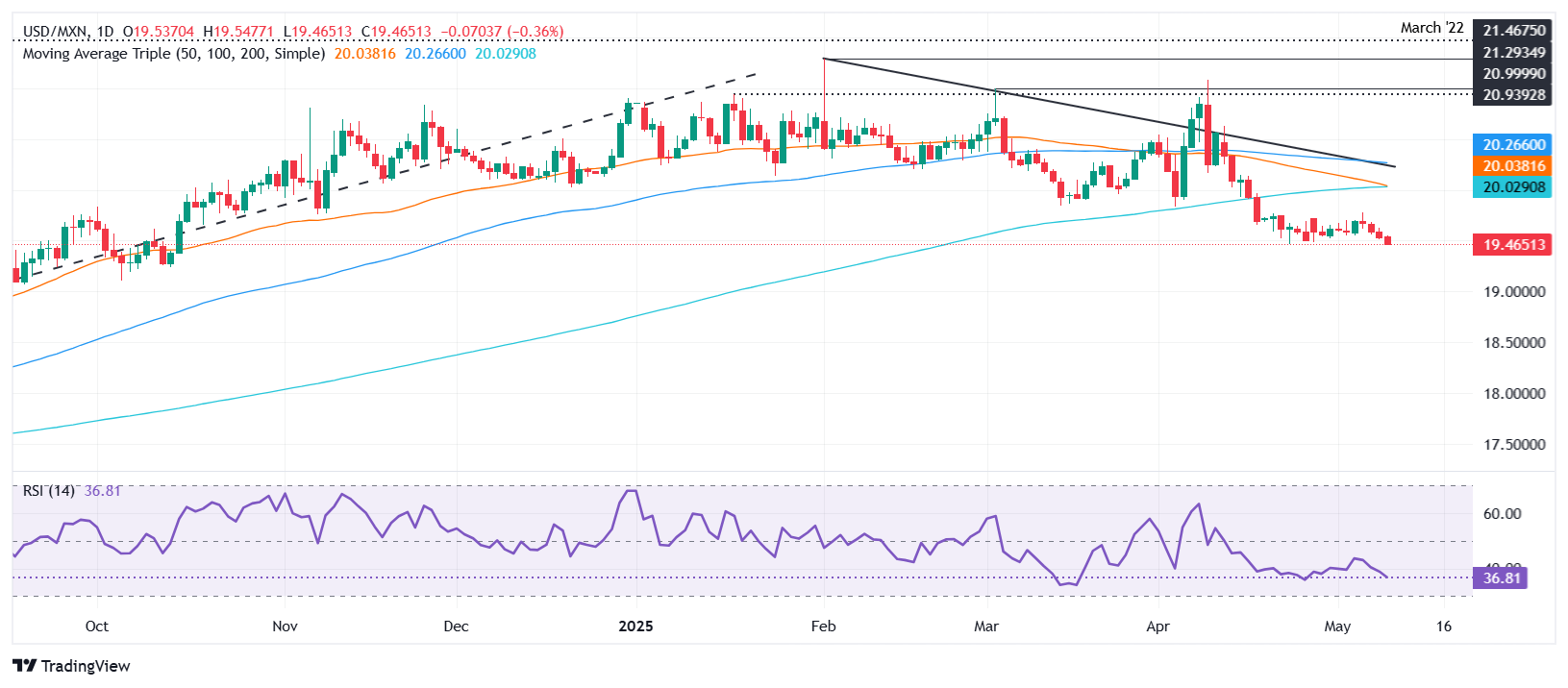Mexican Peso firms despite weak data as trades turn cautious on US-China talks
- Mexican Peso shrugs off soft data, extends four-day rally as traders eye US-China meeting in Switzerland.
- Mexico’s Consumer Confidence dips for seventh month; auto exports slump under new US tariffs.
- Fed officials maintain wait-and-see approach, highlighting uncertainty over tariff impact on US economy.
The Mexican Peso (MXN) registered modest gains versus the US Dollar (USD) on Friday as market participants turned cautious ahead of the US-China talks in Switzerland. The emerging market (EM) currency remained unfazed by a worse-than-expected economic outlook as Mexico’s data continued to deteriorate.
At the time of writing, the USD/MXN trades at 19.46, below its opening price by 0.33%, testing the current year-to-date (YTD) low.
Mexico’s Consumer Confidence, as revealed by the Instituto Nacional de Estadística, Geografía e Informática (INEGI), showed that households have become pessimistic about the outlook in April. Figures fell from 46 to 45.3 for the seventh straight month.
Other data revealed by INEGI included Automobile Production and Exports, with both figures declining as new US tariffs on cars impacted production, leading to a reduction in shipments to the US.
Despite posting dismal economic data, the Peso strengthened with the USD/MXN falling for the fourth consecutive day.
Across the northern border, Federal Reserve (Fed) officials made headlines. They emphasized that current monetary policy is appropriate and that the central bank needs to wait and see how tariffs impact the US economy.
Daily digest market movers: Weakness in the automobile industry to weigh on the Mexican Peso
- Auto Production plummeted 9.1% in April, down from an increase of 12.1% the previous month. Among the major brands that reduced their production are Stellantis, down -46.7%, followed by BMW at -27.1%.
- Mexico’s April Auto Exports plunged by -10.9% following a rise of 3.8% in March, revealed INEGI. Mazda and Volkswagen experienced decreases of -60.9% and -44.4%, respectively, in exports.
- Mexico’s inflation data in April rose by 3.93% YoY, above forecasts of 3.90%. Core prices increased by 3.93% up from 3.64% above estimates of 3.92%.
- Trader’s focus shifted to Banco de Mexico (Banxico) monetary policy meeting in May 15. Economists surveyed by Citi expect a 50 basis point (bps) rate cut by the Mexican institution, supported by the latest policy statement revealed by the central bank.
- Although Mexico’s economy narrowly avoided a technical recession, tariffs imposed on Mexican products, a reduced budget, and geopolitical uncertainties will continue to strain the country’s finances and impact the Peso.
USD/MXN technical outlook: Mexican Peso regains strength as USD/MXN tests YTD low
The USD/MXN is testing the YTD low, yet sellers are clashing with buyers as market players prepare for the weekend. A daily/weekly close below 19.50 could exacerbate a move toward the 19.00 figure.
The Relative Strength Index (RSI) favors sellers, indicating that further weakness lies ahead.
Conversely, if buyers lift the USD/MXN past 19.59, the next resistance would be the 20-day Simple Moving Average (SMA) at 19.66, followed by the 200-day SMA at 19.99 ahead of the 50-day SMA at 20.02.

Mexican Peso FAQs
The Mexican Peso (MXN) is the most traded currency among its Latin American peers. Its value is broadly determined by the performance of the Mexican economy, the country’s central bank’s policy, the amount of foreign investment in the country and even the levels of remittances sent by Mexicans who live abroad, particularly in the United States. Geopolitical trends can also move MXN: for example, the process of nearshoring – or the decision by some firms to relocate manufacturing capacity and supply chains closer to their home countries – is also seen as a catalyst for the Mexican currency as the country is considered a key manufacturing hub in the American continent. Another catalyst for MXN is Oil prices as Mexico is a key exporter of the commodity.
The main objective of Mexico’s central bank, also known as Banxico, is to maintain inflation at low and stable levels (at or close to its target of 3%, the midpoint in a tolerance band of between 2% and 4%). To this end, the bank sets an appropriate level of interest rates. When inflation is too high, Banxico will attempt to tame it by raising interest rates, making it more expensive for households and businesses to borrow money, thus cooling demand and the overall economy. Higher interest rates are generally positive for the Mexican Peso (MXN) as they lead to higher yields, making the country a more attractive place for investors. On the contrary, lower interest rates tend to weaken MXN.
Macroeconomic data releases are key to assess the state of the economy and can have an impact on the Mexican Peso (MXN) valuation. A strong Mexican economy, based on high economic growth, low unemployment and high confidence is good for MXN. Not only does it attract more foreign investment but it may encourage the Bank of Mexico (Banxico) to increase interest rates, particularly if this strength comes together with elevated inflation. However, if economic data is weak, MXN is likely to depreciate.
As an emerging-market currency, the Mexican Peso (MXN) tends to strive during risk-on periods, or when investors perceive that broader market risks are low and thus are eager to engage with investments that carry a higher risk. Conversely, MXN tends to weaken at times of market turbulence or economic uncertainty as investors tend to sell higher-risk assets and flee to the more-stable safe havens.
